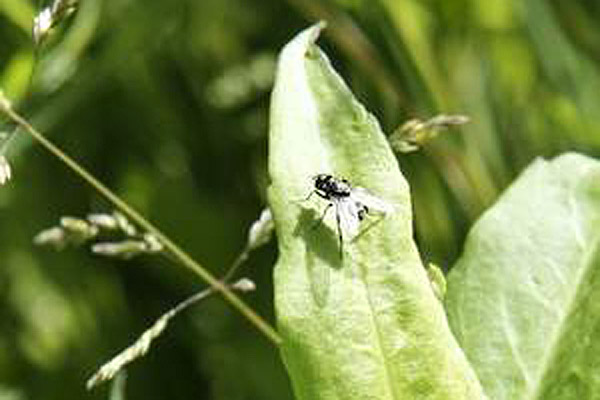
Fly time
Central Delaware residents find biting flies peskier than usual this season
1:32 p.m., June 11, 2012--Have you had more unwanted guests at your backyard barbecues this year?
Other Delawareans are sharing your pain.
Campus Stories
From graduates, faculty
Doctoral hooding
We’re not talking about that pesky, loquacious neighbor or the cousin who stays long after everyone has left, we’re referring to biting flies ruining your good times.
“This is shaping up to be a bad season for flies,” says Brian Kunkel, an entomologist with University of Delaware Cooperative Extension. “Most of the calls I’ve received from the public this spring have been about biting flies.”
At Greg Mannering’s home in Bear, the flies have been bothersome. “I noticed deer flies early; they’re worst in shady areas,” says Mannering.
Unfortunately, Mannering resides in one of the buggiest parts of the state – this season, anyway. “Middletown seems to be the worst area for flies but the entire central portion of the state – Bear to Smyrna -- has been impacted,” notes Kunkel. “It’s the same way with stink bugs and other pests -- outbreaks often are localized.”
Beyond that, Bear and Middletown feature a good amount of the habitat that deer fly need to survive -- marshes and wetlands. While adult deer flies can live in a variety of places, as long as water is nearby, deer fly larvae appear to be limited to aquatic habitats, including marshes, ponds and streams.
But even if you don’t live near a marsh, chances are you’ve got plenty of flies keeping you company. In the U.S., there are about 16,000 species of flies. However, compared to other countries, Americans get off easy -- worldwide, an estimated 145,000 species exist. Only the polar ice caps are devoid of flies.
Entomologists call this order of insects Diptera but most people know them as flies, gnats, maggots, midges, mosquitoes, keds, bots and various other names. Whatever you call them, they’re frequently annoying, often costly, and sometimes downright dangerous.
Flies are expensive and not just because of all those citronella candles you buy before barbecues. Flies contaminate or destroy $10 billion worth of agricultural products annually in the U.S., according to the U.S. Department of Agriculture.
In Delaware, the two flies that farmers worry about most are seed corn maggot and Hessian fly, according to Joanne Whalen, the integrated pest management specialist for UD Cooperative Extension. Seed corn maggot is a slender, light gray fly that feeds not only on corn but on soybean and many vegetable crops.
“Seed corn maggot was a major pest of peas this spring,” reports Whalen.
The larval stage of Hessian fly can be an issue in wheat and was a problem a number of years ago. In recent seasons, this fly hasn’t caused much damage to Delaware crops, says Whalen.
As for the danger flies hold, consider that more than 100 pathogens are associated with the common house fly, including Salmonella, Staphylococcus, E. coli and Shigella. Flies are efficient at spreading disease because they move quickly from things like rotting garbage to landing on your picnic lunch (without washing their feet off in-between).
But many species of flies don’t transmit disease and, in fact, actually serve a beneficial function. The hoverfly, which looks like a small bee, eats aphids and other pests. And a species known as the long-legged fly gobbles up mosquitoes.
“Not all flies are bad,” notes Kunkel. “Some are pests, some are beneficial and some are categorized as incidental -- they neither injure nor aid us.”
To keep the bad guy flies away from your outdoor events, Kunkel suggests several control measures.
Research has shown that citronella and other essential oils are effective natural fly repellants. So stock up on citronella candles; they really do work, says Kunkel.
Mannering also uses natural methods to combat deer flies at his Bear home. “What I do is grab an herb like rosemary or thyme in my garden or some marigolds and rub my hands to help repel the flies and mosquitoes,” he says.
Kunkel has heard good things from Extension colleagues about some of the new personal bug zappers. These appliances are meant to be clipped to a belt loop or worn in a holster.
What doesn’t work well, says the UD entomologist, is DEET and other chemical measures.
“It’s cost-prohibitive to spray your yard with DEET and not very effective, either,” notes Kunkel. “It also can present environmental concerns. Plus, I think many people are uncomfortable with the idea of spraying themselves and their kids with DEET every time they go outside.”
Learn more
Got a fly question that’s bugging you? Meet Brian Kunkel and other UD Extension experts at the June 20 open house at the Native Teaching Garden at the New Castle County Extension office in Newark. Master Gardeners are sponsoring this event, which is free and runs from 6 p.m. to 8 p.m. Call 831-COOP for more info.
Article by Margo McDonough
Photo by Danielle Quigley








